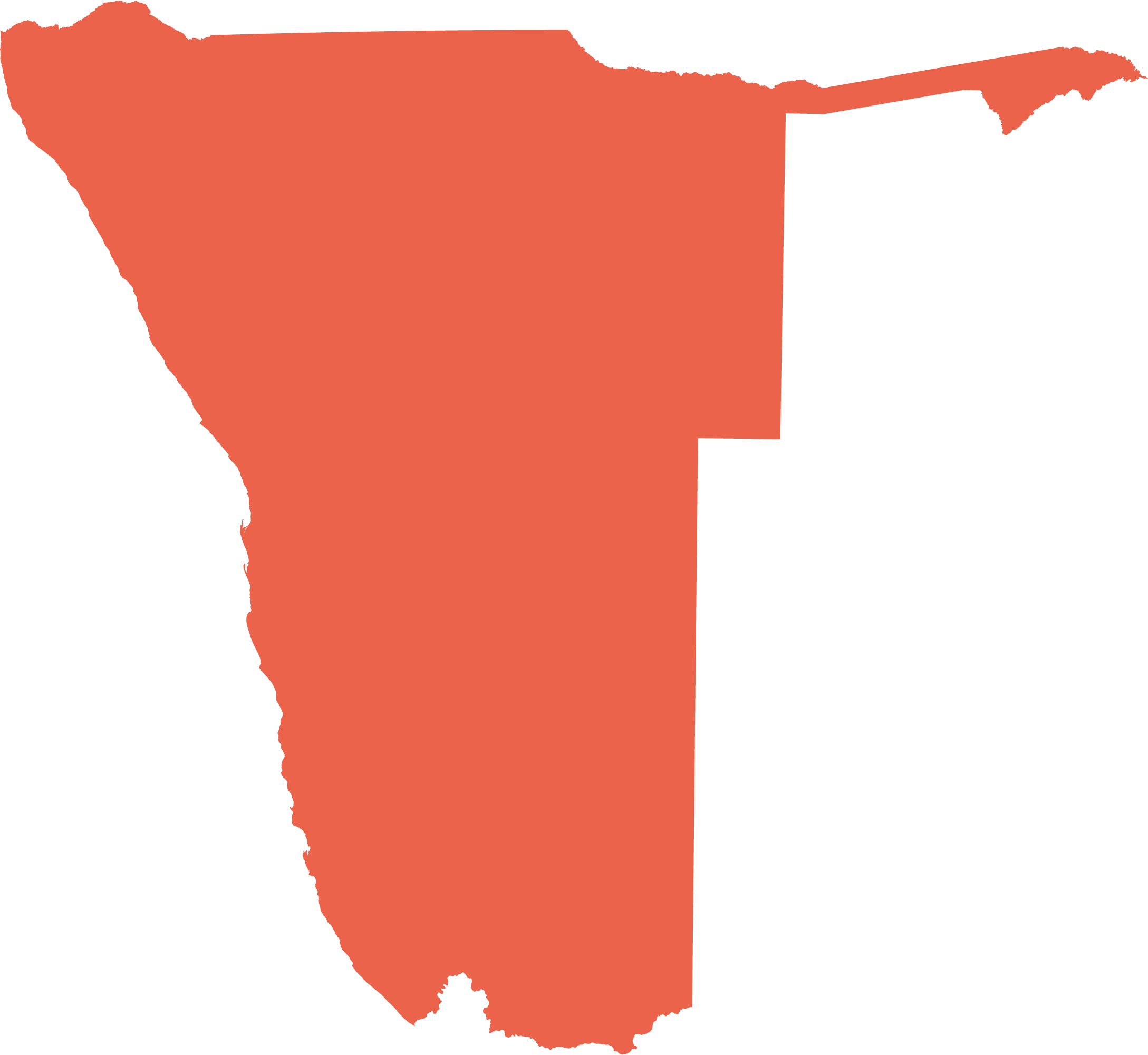Invasive alien plants15
The productivity of large areas is lost to encroaching bush and to clearing for crops. Alien plant species cause similar losses. By definition, alien plants do not occur naturally in Namibia; they are not indigenous, and have been introduced by people, either deliberately or accidentally. Alien species can be benign, but some are harmful by invasively spreading over large areas, usually to the detriment of indigenous plants and natural habitats. Not all alien plants are invasive, and many beneficial ones have been introduced, including food plants and ornamentals. No-one knows the number of alien plant species in Namibia, but at least 220 species have become naturalised, meaning that they propagate themselves without assistance from people.16 While most of these plants are harmless, at least 60 species have become problematic and a variety of invasive aliens occur in almost every corner of Namibia. Records of alien plants in Namibia far under-represent their number and extent.
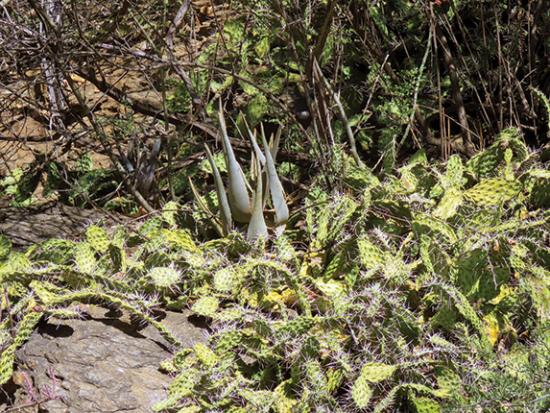
Photo: B Curtis
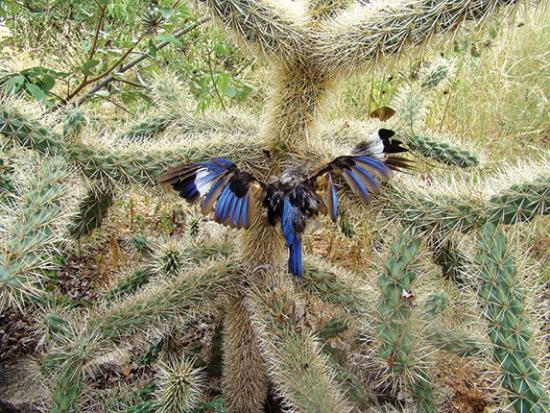
Photo: H Zimmermann

Photo: J Mendelsohn
Alien plants thrive and spread if they are suited to Namibian conditions, often because the pests, diseases and competitors that control their natural viability in their countries of origin are not present here. As a result many outcompete, displace and smother indigenous plants. They form thick stands that animals cannot move through. Others are poisonous or have thorns on which animals are impaled, such as the kingfisher (second photo above). Where invasive plants invade agricultural land, they deplete nutrients in the soil, and take time, labour and money to remove, such as the cacti (first photo above). Not only does the land lose productive value, but alien plants also use large quantities of water, invade watercourses and interrupt the natural flow of water, as do these prosopis trees clogging the Olifants River east of Uhlenhorst (above).
6.23 Habitat-transforming alien plants
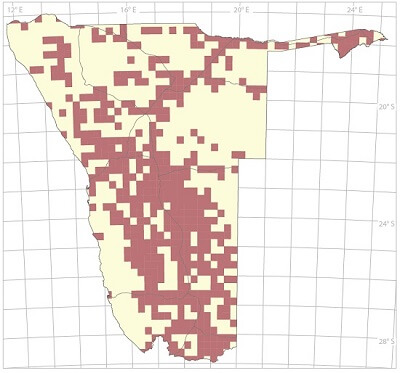
At least 27 species can form stands so dense that no indigenous plants can grow there and animals cannot pass through them. Many of these species are associated with water. The worst of these species are Madagascar rubber vine (Cryptostegia grandiflora), various cacti (Cactaceae) and Prosopis species.
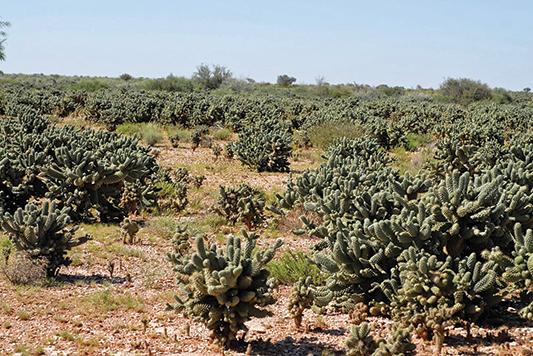
Photo: C Mannheimer
Boxing-glove cactus (Cylindropuntia fulgida var. mamillata) covers much of this area.
6.24 Distribution of the Madagascar rubber vine
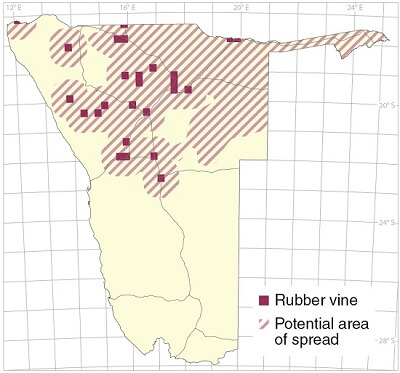
Madagascar rubber vine (Cryptostegia grandiflora) was recently introduced as an ornamental plant. It climbs over any support, thus smothering trees, and produces small seeds with long silky hairs, which are blown far from the parent plant. It is found in all towns from Windhoek northwards, and has been planted on many farms and lodges, from where it is now spreading into the wild. In Australia, where it has also been introduced, it has smothered and killed vast areas of forest and pasture, and choked waterways. The plant prefers areas that receive more than 400 millimetres of rain per year, and could potentially damage Namibia's northern woodlands.
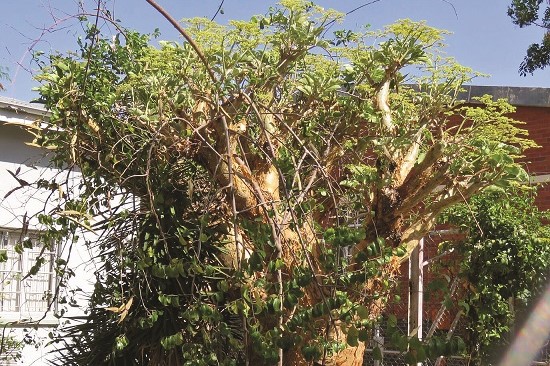
Photo: B Curtis

Photo: C Mannheimer
A protected indigenous tree (Cyphostemma currorii, kobas) is invaded and smothered by rubber vine. This could happen to indigenous woodlands. Note the great numbers of seed pods.
6.25 One cactus, many cacti!
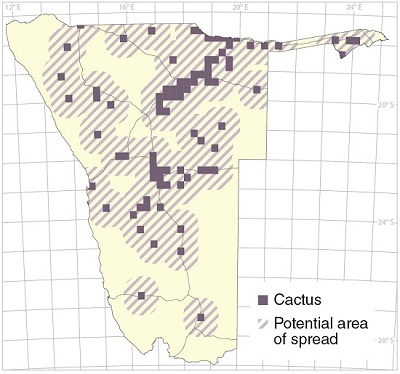
Native to arid parts of the Americas, about 22 species of cactus are now invasive in Namibia, many having been deliberately planted by well-meaning people who want 'water-wise' plants. Unfortunately, many cacti spread to form dense, impenetrable mats with vicious thorns. Animals that pass by become impaled on the thorns; the thorns also stick in the throats of livestock, preventing them from feeding. The seeds of cacti are spread far from the parent plants by birds and baboons that eat the juicy cactus fruits, and the stems or 'pads' root where they drop. In South Africa, vast tracts of farmland have been lost to cacti at huge economic cost through land loss and control. Many species are spreading rapidly in Namibia, thus posing a serious threat to our indigenous vegetation and land potential.

Photo: C Mannheimer
6.26 Water-demanding alien plants

Three alien aquatic species are found in Namibia's perennial rivers, of which Kariba weed (Salvinia molesta) is the most problematic. About 20 other species are associated with watercourses (ephemeral and perennial) and water points, three of which – prosopis (also called mesquite), gumtrees (Eucalyptus species) and pepper trees (Schinus molle) – consume excessive amounts of water. Prosopis has choked some of Namibia's eastward- and southward-flowing rivers. Aliens such as Madagascar rubber vine and lantana (Lantana camara) block animals' access to water.

Photo: B Curtis
There are three species of prosopis in Namibia; Prosopis glandulosa is most common. Prosopis trees were introduced to Namibia from the arid Americas for shade and fodder. Although drought-tolerant and nutritious, they use a lot of groundwater and have invaded pans and rivers such as the Fish, Nossob and Orange. They outcompete indigenous riverine trees by depriving them of groundwater and, in places, they have completely choked the riverbed. Livestock eat the pods, which helps spread the seeds.
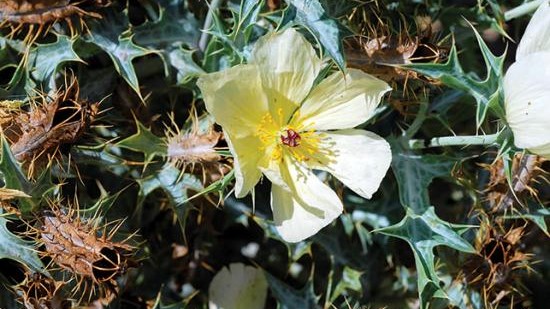
Photo: C Mannheimer
Mexican poppy (Argemone ochroleuca)
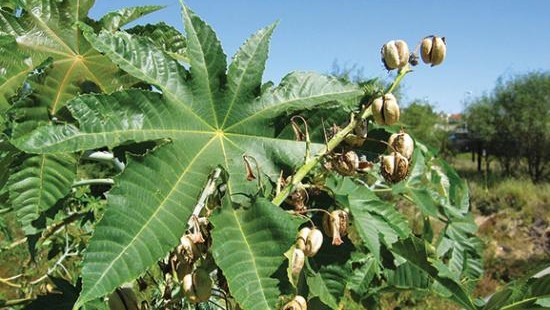
Photo: C Mannheimer
Castor-oil bush (Ricinus communis)
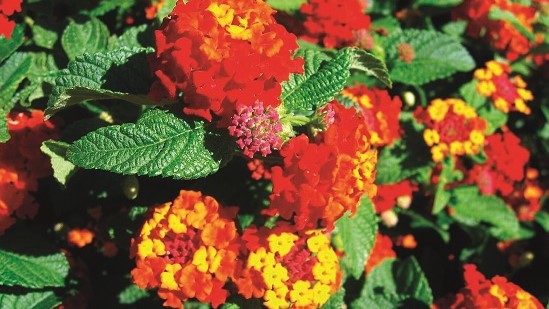
Photo: C Mannheimer
Lantana (Lantana camara)

Photo: C Mannheimer
Downy thorn-apple (Datura innoxia)
Other aliens associated with streams and rivers include: Mexican poppy (Argemone ochroleuca); castor-oil bush (Ricinus communis); lantana (Lantana camara); downy thorn-apple (Datura innoxia). All of these species are poisonous, and can form dense stands that exclude native plants. They also invade disturbed areas.
6.27 Invaders of disturbed lands
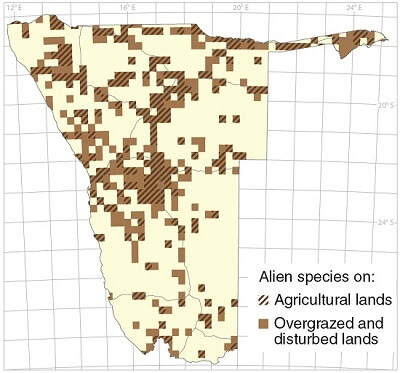
More than 30 alien plant species have invaded disturbed lands such as roadsides, kraals, water points and overgrazed or cleared areas. Of these, about 15 are crop pests.
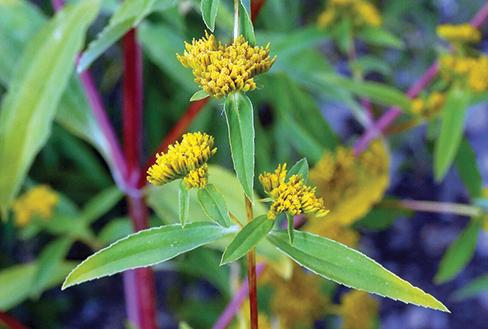
Photo: C Mannheimer
Smelter's bush (Flaveria bidentis) typically invades agricultural and disturbed areas.
6.28 Poisonous alien plants
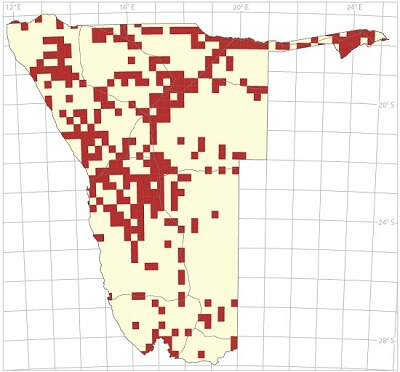
Nearly 20 species of invasive alien plants are poisonous to humans, livestock or other animals. As the map shows, they are widespread across the country, and should be eradicated. Many of them are associated with riverine habitats.
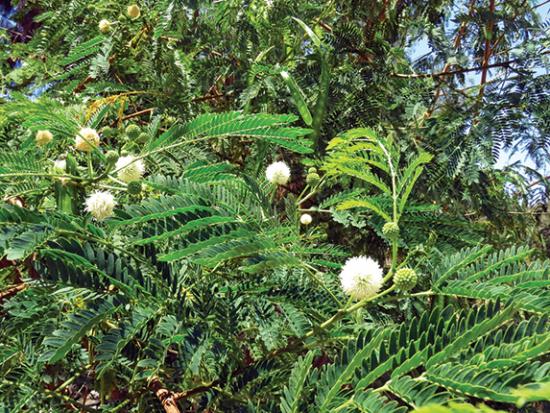
Photo: B Curtis
The wonderboom (Leucaena leucocephala) is poisonous, highly invasive and spreading fast throughout Namibia.

Photo: C Roberts
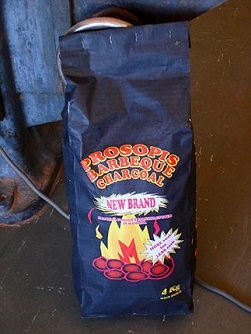
Photo: C Roberts

Photo: G Voigts

Photo: J Mendelsohn
Invasive alien plants in Namibia should be eradicated. This can be done by manual or mechanical clearing, which is the method used to clear and produce charcoal from prosopis. Cacti are also cleared manually in Windhoek, but this is time-consuming and can disturb the soil. Using chemicals is expensive and can be detrimental to non-target plants and other organisms. One natural control agent of invasive cacti has been used in Namibia for some time. Three more were released in 2019, and measures have been put in place to monitor their spread and effectiveness. Using natural animal pests of invasive species requires careful research to ensure that the introduced pest will not also attack indigenous plants. In Namibia, the salvinia weevil (Cyrtobagous salviniae) has been used to control Kariba weed (Salvinia molesta) in the northeastern rivers. The small beetle eats the growing tips of this highly invasive waterweed, which is native to Brazil. Left unchecked, the weed forms dense mats in slow-moving water, shading submerged plants and reducing water quality.
